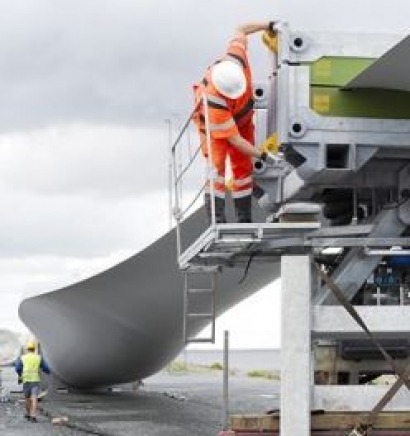
The length of the 25 ton fiberglass blade is 75 meters. Each rotor on the new turbine has a diameter of 154 meters covering 18,600 square meters, which is the size of two and a half soccer fields.
The tips of the blades move at up to 80 meters per second, or 290 kilometers per hour.
The industry trend is clearly heading in the direction of longer and longer rotor blades. The Siemens rotor consisting of three 75-meter rotor blades has a diameter of 154 meters and covers a surface area of approximately 18,600 square meters, equal to about two and a half soccer fields.
The Siemens 6 MW wind turbine will generate about 65 percent more energy using the 75-meter rotor blade compared with the Siemens 3.6 Megawatt bestseller using the earlier blade with a length of 58 meter.
Dong Energy ordered a total of 300 6 MW wind turbines featuring the record rotor measuring 154 meters in length. These wind turbines are to be installed in wind power plants off the British coast between 2014 and 2017.
Earlier this week the blade was loaded onto a special transport vehicle in the post of Esbjerg for its 320 kilometer trip to Østerild. The vehicle was 85 meters long, five meters wide and four meters high.
The route included 9 roundabouts, through which the special transport vehicle, with a total length of more than 80 meters, had to maneuver. To negotiate the curves, the wheels of the rear trailer also had to be precisely steered.
In a written statement, Siemens said the weight of rotor blades is a critically important factor. Thanks to the patented IntegralBlade process, Siemens is capable of producing especially light rotor blades.
Heavy rotor blades are exposed to higher loads and necessitate sturdier nacelles, towers and foundations. Consequently, the combination of intelligent design and low weight has a positive effect on the power generating costs of wind turbines.
Once installed in a wind turbine, the 154-meter rotor must withstand huge air masses. At wind speeds of ten meters per second, it captures the energy of 200 tons of air every second. Siemens' patented QuantumBlade technology assures that the rotor blade is up to 20 percent lighter than rotor blades produced with conventional methods.
For additional information:

